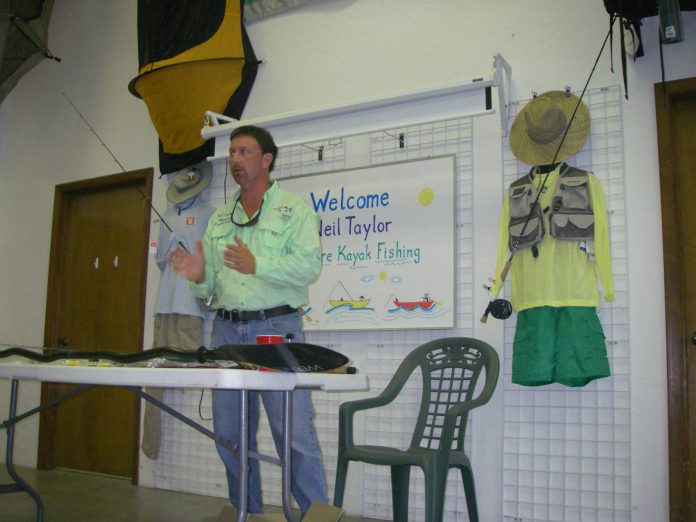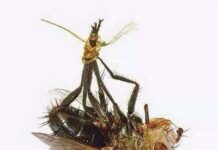By Neil Taylor, www.strikethreekayakfishing.com
It was the best of days; it was the worst of days:
“Look at the pictures of all my fish we caught today!”
(Pause) “You mean you went out in that today???”
With the right approach, plan and equipment-fishing success on the tougher weather days is achievable. Utilizing a kayak, access to protected waters keeps you out of the rougher open waters and puts you right where the fish seek shelter.
The smart angler will utilize weather and wind forecasts for making decisions on when, where and “if” they are going fishing. Mother nature can be cruel sometimes. People have tried to go out on the days when the wind is howling and the conditions are inclement- “beaten up” and weary, they may wonder why they didn’t stay at home instead
“Enter kayak fishing.”

Days where the National Weather Service has issues a Small Craft Advisory, people will be amazed to read later that day of a great fishing trip I’d taken when they had a tough time or, decided not to go at all. With the right plan, this is something that can done comfortably and safely.
This situation is what I describe as “Small Craft Advantage”. Knowledge of local waters plays a large role in this endeavor but the situation is, on days like this, the kayak angler can launch in areas to access fish that people in the powerboats may not want to travel to or navigate. The shield of trees, land or buildings knocks down the wind’s affect. It also usually concentrates the fish in the same locations placing angler and fish in great possibilities for interaction. Particularly when seasonal patterns have fish in sheltered areas, a kayak angler can get in on the action on days where the powerboats won’t leave the ramps, their personal dock or marinas. Covering some distance, if the correct location is selected, the kayak angler will enjoy a lot of relief from the wind getting to the fishing location and back to the launch.
For obvious reasons, these outings cannot be taken haphazardly. Use very good judgment on taking trips on the worst weather days, not only with choosing the appropriate location but being alert to changing conditions at all times. Wind, lightning and exposure to the elements can be extremely dangerous and life-threatening. The worst mistake that can be made is decisions to enter “wide open waters”, with little to no protection from the wind, where it can be impossible to paddle in strong gusts, waves and current. This is not a good plan and has resulted in numerous kayak angler deaths. Resist the urge to take those risks and stay in the safer areas.
This pop-up thunderstorm is coming directly toward us. 45 minutes at “Kimmy Key” is the plan-of-action.
Regardless of location selection, the kayak angler should have a way of monitoring for approaching weather and always be ready to seek a protected area to sit out the worst weather situations. Today’s phones give anglers the ability to watch storms on their own but can also be used to talk to someone who can be your “weather watcher” (Note: “Dry Bag” below).
If there is approaching weather and there is not adequate time to return to the launch, proceed immediately to “The Safe Spot” [A pre-selected location for that area where you have reasonable shelter from the elements]. This will be a location you know that you can sit with your kayak secured until the weather passes. When the worst weather is imminent, the biggest mistake made is to “make a run for it”, crossing open waters to reach the original launch point, when it is better to utilize your pre-designated Safe Spot and wait out a squall. Graphite fishing rods are a significant lightning attractor, so lay all the rods down and if possible, get away from that location.
“I shouldn’t be alive”. The “rental” kayaker in the foreground was rescued by Neil Taylor when the wind and waves drove his kayak under the waves, just seconds after this photo was taken. A decision to “stay on that island, instead of crossing in this storm” would have been the better decision.
Properly securing your kayak also includes “dropping your anchor.” Even if you have put your kayak on dry land, drop your anchor so that wind and waves do not send your kayak adrift.
Covering the many safety aspects with “braving the weather”, there are items that are critical to have.
The Float Plan
This is the same as with other water users. The float plan consists of telling someone where you are going and what time you will be coming back. Should there be a situation where you are unable to be in touch with civilization, the information provided to the keeper of your float plan will create an opportunity for rescue.
The Personal Flotation Device.
Kayak anglers must legally always have a “PFD”. The auto inflate vest is a great safety net, particularly for the angler who fishes alone. If the angler ends up in the water, the vest will inflate greatly reducing the odds of drowning. In most cases, falling out of a kayak entails “standing up” in our local shallow waters, but it is (by design and function) a safeguard against drowning. If you use the auto-inflate PFD it is legally mandatory that you wear it.
The Dry Bag
Access to help via cell phone or VHF radio is important.  Faced with an emergency, without access to one of these items, crisis could become tragedy. The dry bag is something every angler should have and utilize to protect their valuables that must not get wet, one of which is the cell phone. Faced with a situation you cannot handle alone, being able to access assistance is crucial. Always properly close your dry bag. During rainstorms, water collecting in a kayak can submerge a dry bag. Properly sealed, all the contents will remain dry and undamaged. Your local kayak shops all carry dry bags and are an item that is an investment in your safety.
Faced with an emergency, without access to one of these items, crisis could become tragedy. The dry bag is something every angler should have and utilize to protect their valuables that must not get wet, one of which is the cell phone. Faced with a situation you cannot handle alone, being able to access assistance is crucial. Always properly close your dry bag. During rainstorms, water collecting in a kayak can submerge a dry bag. Properly sealed, all the contents will remain dry and undamaged. Your local kayak shops all carry dry bags and are an item that is an investment in your safety.
Fishing Success:
For all anglers but particularly paddle-anglers, the right plan is based on “know where to go.” Winds whipping over exposed areas are not good for fishing and a nightmare to paddle. Hugging wind-shielded shorelines in backcountry areas, the kayak angler can stay dry, warm and get into the areas the fish like to go when poor weather has settled in. Casting and retrieving lures is much easier than in the windswept areas.
Ultimately, if you have selected the right location, the situation should not be significantly different than most other days on the water. Casts along the wind shielded shorelines are good but in the confines of creeks, canals or rivers there may be fish wherever the best habitat is. That may be in the areas where there is a little more wind getting over the treetops.
Some days it’s just better to do other things. There are days when even trying to get out to a sheltered area aren’t easy to do, and definitely not enjoyable. There are other days you will really miss out on spectacular action. Via kayak, accessing these fish is possible and some of the best trips you’ll ever have will be on the days everyone else didn’t venture out at all. Use this tool to your advantage but be smart, be safe and enjoy the results

- The Neil Blog… - July 26, 2023
- The Catfish - July 26, 2023
- update - July 22, 2023
















